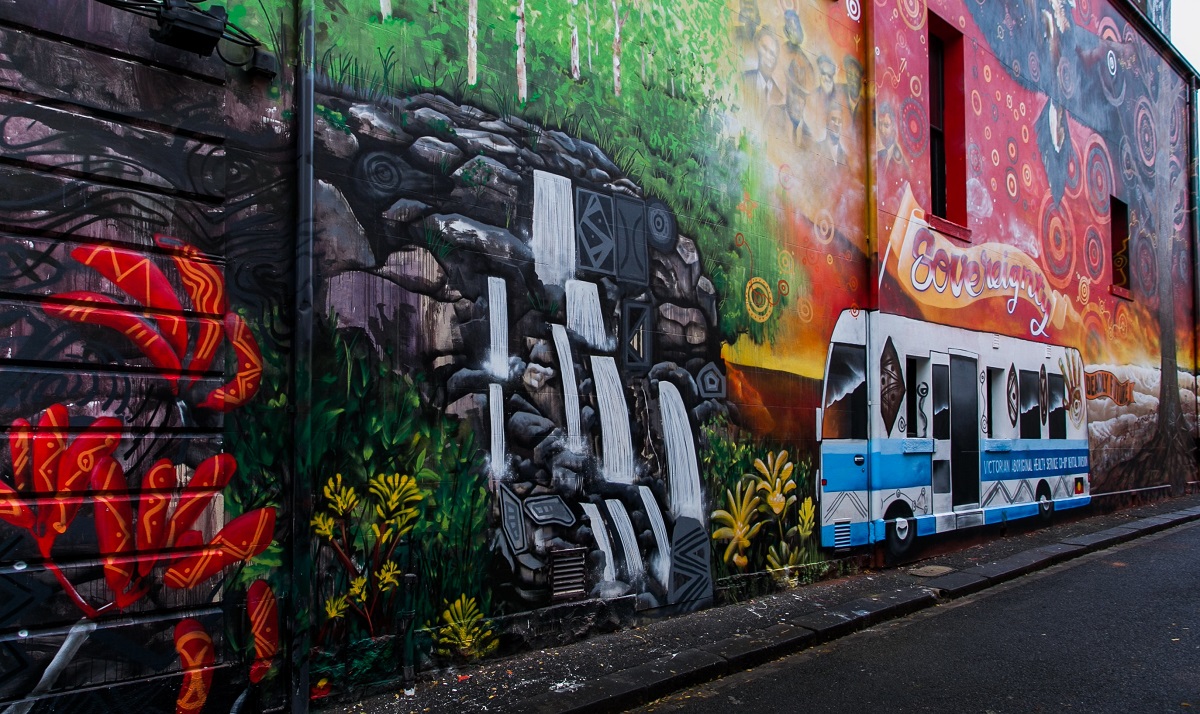New mural celebrates Aboriginal culture in Gertrude Street
Tuesday 25 July 2017

Down a side alley at Fitzroy’s thriving social enterprise restaurant, Charcoal Lane, a new street art installation by Gunnai Waradgerie man Robert Young is already turning heads.
Designed by Mr Young and produced alongside Heesco and Makatron, the mural took four days to complete and was created in partnership with Charcoal Lane, Yarra City Council and funded by the Victorian Government’s Community Crime Prevention Program targeting graffiti in the area. Incorporating the past, present and future, the artwork - Celebration Dreaming - references Aboriginal identity, connections and culture in Fitzroy and highlights the significance of the area, and building, for the artist and for the local Aboriginal community.
Mr Young explains his artwork was inspired by his family’s long-reaching history in the area. “My great, great grandparents were the first Aboriginal people to live on Gertrude Street in Fitzroy, setting up the first church for local Aboriginal people in their home. My grandfather and grandmother created one of the first Aboriginal legal services in Australia here in Fitzroy. And my mum worked as a dental nurse on the dental bus run by the Victorian Aboriginal Health Service which was originally based where Charcoal Lane is now,” said Mr Young.
The family continues to have a presence in the area, with Mr Young’s cousin recently graduating from the social enterprise program at Charcoal Lane. Reflecting on the finished artwork, Mr Young said: “I was really excited to be selected as it gave me an opportunity to showcase our history and culture, and to really pay homage to the past on such a prominent wall in Fitzroy. It’s an opportunity to celebrate our culture and share it with the local community, so they too can be part of that story.”
Yarra City Council Mayor, Councillor Amanda Stone said, “Council is delighted to support this mural, a dramatic and beautiful visual representation of the achievements, culture and history of the local Aboriginal community. Like many Victorian Aboriginal people, Mr Young and his family have a special connection to Gertrude Street and Fitzroy. It is wonderful to see the Indigenous history of the area through the lens of a young, contemporary Aboriginal artist.”
About Celebration Dreaming
The first image seen from the street features elders including founding members of VAHS and other Aboriginal organisations and services that were established around Fitzroy, as well as a waterfall as a nod to the past and “drawing on the well of wisdom”. Featured in the centre of the artwork, the dental health service bus highlights Mr Young’s mother’s generation and the many Aboriginal communities who experienced a visit from the bus. The VAHS dental bus was critical in bringing much needed help to regional communities and it is depicted to acknowledge their longstanding service and the vital role VAHS―now relocated close by―continues to provide for the community.
The imagery of a tree symbolises the future, highlighting the spiritual and cultural connection to country that local Aboriginal people have today, also reflecting interconnectedness, networking, kinships, creativity and continual growth. Bunjil the eagle is acknowledged by the Wurundjeri Tribe as a creator spirit and features in the artwork to symbolise the future for local Aboriginal people in the area. Current students at the Charcoal Lane program also contributed their handprints to the artwork to symbolise their part in creating the future.
About Charcoal Lane
The feel-good fine dining offered at Charcoal Lane unites Aboriginal heritage with the trendy Fitzroy gastronomy experience, all while providing a supported, hands-on Mission Australia traineeship program for young Aboriginal & Torres Strait Islander aspiring chefs and hospitality stars. Mission Australia’s Troy Crellin, Program Manager of the social enterprise, explains: “Charcoal Lane is a celebration of Aboriginal culture past, present and future. Now, we’re not only serving a culinary story spanning hundreds of generations but our exterior features a powerful reminder of local Aboriginal heritage. For Charcoal Lane students, this mural is an important recognition of their history.
“Our building was home to the Aboriginal Health Service from 1973 to 1992, and this mural recognises the important part this building has played in lives of our student’s families and all Aboriginal and Torres Strait Islanders; it fosters a sense of cultural and community pride. When the mural was completed, one of our students took photos home for his Nan. When she saw them, she spent the next hour explaining the relevance of the mural and her own connection to local history,” said Mr Crellin.
Photo: J Forsyth
